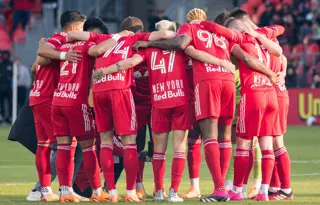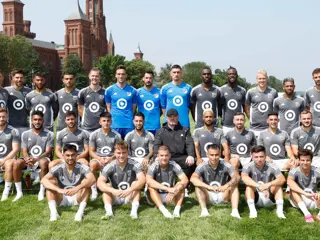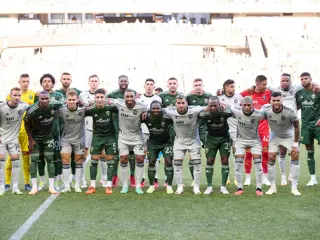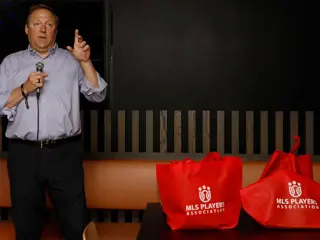News
MLSPA: Building solidarity within the union every day

Twenty years ago, Bob Foose was approached by a group of Major League Soccer players with one goal in mind: unionizing professional soccer in North America. He did just that after securing the assistance of accomplished union-side labour lawyer Jon Newman.
Now two decades into his role as Major League Soccer Players Association (MLSPA) Executive Director, Foose spoke with FIFPRO about the organization’s history, main accomplishments, and goals.
“To tell the story of the Players Association (PA) is to tell the story of the players,” said Foose. “The PA is the voice of the players – they are the foundation of everything the PA does and has accomplished. They’re the ones who have put in the time and work since the PA’s inception. Without their efforts and continued solidarity, the PA would not be where it is today.”
History
A group of MLS players approached Foose, then a transactional lawyer in Washington, DC, after the loss of an antitrust case against the league in 2003. “I knew nothing about forming a union. But I knew these players, the league, and the industry.”
When Foose ultimately took on the challenge, he knew the first thing he had to do was secure assistance. Upon recommendation, he ended up in the offices of Sherman Dunn, P.C. across the table from Newman. “Jon came on board, and we set off to help the players.”
Foose and Newman then began the arduous process of negotiating the league’s first collective bargaining agreement, which, little did they know, would take a full 18 months. The union was welcomed by MLS players, who at the time were still playing with little to no rights.
“The players weren't represented when the league was formed, which enabled the league to utilize 50 years of US sports law to design a system that systematically stripped away every conceivable player right,” said Foose. “The minimum salary for senior players was $24,000, which was not a dollar more than when the MLS started in 1996. Some players earned even less, making $950 a month. These were professional athletes working a full-time job without health insurance, or any benefits at all. Many players had to have second jobs to make ends meet.
“There was no dispute resolution system, no retirement plan, no framework for players to negotiate anything. Contracts were not guaranteed and if a contract was terminated, the club would still retain the player’s rights, which meant the player couldn't work for another club in the league.”
One positive was that the player union was quickly recognized by MLS and the club owners. “I know a lot of FIFPRO members will be shocked to hear this but, in the US, generally speaking, leagues and owners understand that it's actually better for business to have your players organized and unionized than not. You see a correlation between the formation of unions and greater success. If you want to be a strong league, then there needs to be a player union.
“That didn’t mean that improving our players' rights was easy, though. The players had to fight for everything that they got and are going to get.”
Accomplishments
Major League Soccer has undergone enormous changes since the MLSPA’s formation in 2003. Among them, the number of teams has increased from 10 to soon-to-be 30 while attendance rates and popularity have also grown significantly. Most importantly, players’ rights have grown in parallel. “We're not fighting for those basic rights anymore. Thankfully players are not just making a living wage, but a good wage.”
The MLSPA managed to improve players’ working conditions and pay each time they negotiated a new collective bargaining agreement. However, Foose explains that this is not their biggest accomplishment.
“What the Players Association has given MLS players is a voice which they didn’t have when this league was formed,” said Foose. “Players have taken that very seriously and worked hard to make sure that their collective voice is heard.
“Fundamentally, being a player in MLS is a much more positive experience today than it was when we started, and that's all because of the players.
“At its core, it’s a great union story. In the first eight years of the league, nothing changed. No progress was made in building players’ rights. That all changed when the players came together and exercised their collective power to build a union, seize their voice and make improvements. And that's what we keep trying to do.”
Among the MLSPA’s chief accomplishments is securing more freedom of player movement. “We were able to achieve free agency without a work stoppage in 2015, which I'm not sure had been done in decades in the US sports landscape without either a lawsuit or a work stoppage. That’s a massive accomplishment.”
Player solidarity among MLSPA’s 800+ members is the key to success, according to Foose. “It's something we talk a lot about and the guys really take it to heart. What the players have today, they have because of the work that was done by players before them. They owe it to those players to put in the same work to try and make it better for the next generation.”

Much of the MLSPA’s efforts are focused around maintaining the two key factors of its success: trust and solidarity.
“We spend the majority of our time, in one form or another, maintaining and building the solidarity within the player pool and their trust in us. That in turn makes it easier when it’s time to negotiate because what we get at the table is based more than anything on how much solidarity there is amongst the player pool.
"It's not rocket science from the Executive Director that gets these gains – it's having the players together and articulating what it is that matters most to them and what they have to have in an agreement.”
For that reason, Foose always wants to have as many players as possible involved with the negotiations. “They're the ones who can speak most articulately and intelligently to the issues that we're talking about at the table. Their credibility is unassailable. And the reality is, management will say things to us that they will not say directly to a player.”

Challenges
Just as the status of players has changed over the last 20 years, their expectations of the union have changed as well. As the needs of players evolve, they expect their union to evolve and respond accordingly.
“I told our staff after the last CBA: if all we’re prepared to do in the next negotiation is what we just did but a little bit better, then it's going to be a problem,” said Foose. “We have to ensure we always have our finger on the pulse of what’s important to our players, what they want and need, and try to provide that.”
Another challenge is making MLS more competitive; the US doesn’t have the pyramid structure that all other countries have, and parity is important to the league as all clubs are sharing in the revenue MLS generates.
“We need to get ourselves closer to the system that you see in the rest of the world,” said Foose. “MLS puts an excessive focus on parity, which has led to too much protection for clubs who are not competing.
“We will continue fighting for basic fairness and more competition. Our players compete every day. They succeed and fail every day. Everyone in soccer understands that world. We want to see the league structure, the management structure, operate the same way, because we believe in competition. It will make us better.”







